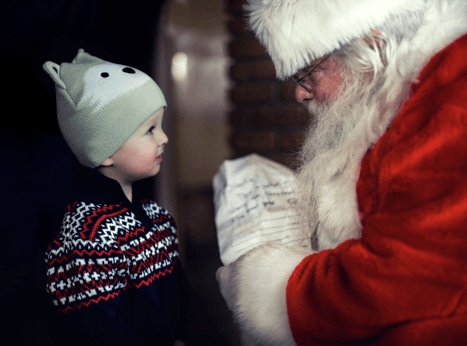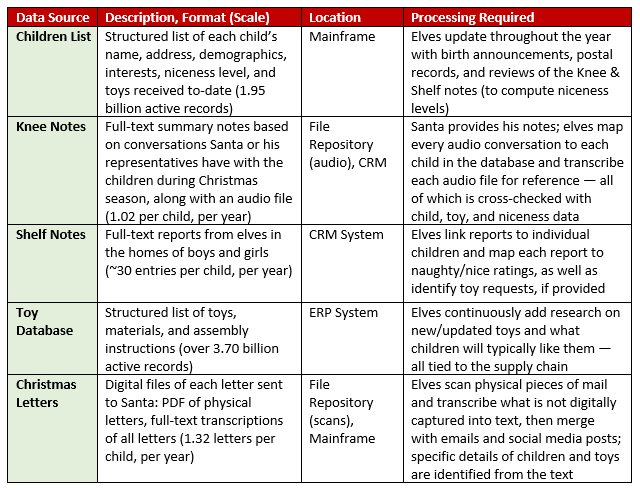The countdown is on for Santa Claus’s annual sleigh ride, when he brings Christmas cheer to (nice) girls and boys. What you may not know is there’s a new factor shaping the North Pole’s 2018 toy delivery: Artificial Intelligence (AI).
Like all modern executives running data-heavy enterprises, Santa has been intrigued by AI and has been considering how it will transform his business (making and delivering toys). But unlike 95% of his peers, the Big Guy in Red has extensively incorporated AI into his day-to-day operation.
How has Santa been able to not only develop, but also act on an AI strategy? It starts with a business-oriented approach, an understanding of data, and a “get to production” methodology.
Maintaining Focus on Business Objectives and Challenges
With centuries of experience as an early adopter of new technology, Santa knows to maintain focus on his business objectives. He knows he cannot treat technology as just a novelty, but as a tool to improve the key mission: maximizing the happiness of nice boys and girls around the globe by delivering toys on Christmas.

While he may have some magic on his side, when Kris Kringle considers his operation at the North Pole, he notes key challenges:
- Increasing kid-to-elf and toys-to-elf ratios, plus elf work hours: The global population of kids is nearing 2 billion, increasing faster than his elves can keep up with, leading to longer work hours and a disgruntled production team.
- Increased variety of toys: The growing variety of toys increases the difficulty of mapping options correctly to each child.
- Increased range of materials, and assembly time per toy: Each toy requires different materials, and construction times can range dramatically. Lincoln Logs (simple wooden tools on the market for 100+ years) are much easier to produce than the Anki Cozmo robot or the (ever-dreamier) Barbie DreamHouse.
Santa is using AI to address these challenges, ensuring a cheerful Christmas for the kiddos — and happier elves in the North Pole.
Understanding Available Data: Format, Location, Processes
Father Christmas has done his research and understands that AI solves defined tasks by learning from data. Which means he needs to understand his data and the tasks performed with it.
At a high level, North Pole data sounds simple enough: a list of each child in the world, detailing where they live, whether they were naughty or nice, and which toys they should receive. Santa works with his elves to make that list and check it twice — but the devil is in the details, as they say.

To better understand his data, Santa commissioned an analysis, summarized below:

Based on the study, it’s very clear that Santa has data, lots of data. But it’s also clear the data currently requires work and governance to make it useful for each current year and referenceable in years to come.
Executive Learnings While the Machines Are Learning
Santa Claus has been reading up on AI case studies, and a common theme is that productivity gains and true ROI come from getting AI into production. His goal, then, has been to find practical applications that drive impact he can improve upon, rather than just expecting the machine to learn everything. In essence, he strives to avoid long-term moonshots in favor of continually improving useful AI applications.
Father Christmas does have eyes on his moonshot: An attempt to throw all the Children, Toy, Letter, and Notes data into a master model that could spit out an annual delivery list with no elf effort (and thereby be able to find different work for the elves). But, thus far, it hasn’t proven practical to do so, especially because the best data doesn’t arrive until just before the big night and the processing power required might actually melt the North Pole.
His primary focus, then, has been on Intelligent Automation use cases (as we initially discussed last year) — which put AI to work on the manual aspects of his operation, such as the data collection and processing work of the elves, including:
- Letter Processing: Identifying children and toys from scanned paper mail, emails and social media posts (fax is no longer used by the children).
- Shelf Notes Processing: Classifying the nightly reports of those elves that sit on shelves into naughty/nice (with severity levels), along with the occasional identification of a toy request.
- Toy Popularity Planning: Proactively analyzing hot toys of the season, specific toy demand, and assumed childhood excitement levels from open-source news and social media.

Value has been achieved in each of these three examples, all retaining some level of elf involvement to assist the machine with validation and updates to the predicted data points to complete the work and re-train the machines. This has decreased elf work hours while improving the toys-to-elf ratio.
AI now underpins all the data work in the North Pole, a continual interaction between elves and machines. But it’s not just the machines that are learning: every new model that is introduced or enhanced is also a teaching moment for Santa to improve his understanding on how AI can transform his operation.
AI at the North Pole
Santa Claus is well along his journey of implementing AI within the North Pole. Keeping his business objectives in mind, Santa has a strong grasp of his data — what it is, where it is, and how it’s used — and is on a continuous learning path so that he and his elves can make the most of AI.
Also published on Medium.




























